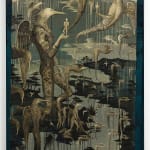





Bill Hammond
2030 x 1285mm framed
Further images
Bill Hammond’s artistically transformational trip to the sub-Antarctic Auckland Islands in 1989 is one of the most mythologised stories in New Zealand art history. It was there that he encountered a staggering abundance of avian life, much as would have existed on the main islands of New Zealand before humans arrived. After this journey, the artist began to incorporate anthropomorphic bird figures into his paintings. Engaged in a range of esoteric rituals and activities, Hammond’s birds have become one of the most recognisable motifs in New Zealand painting of any era.
Dunedin photographer Lloyd Godman was also on that trip, where he took some now iconic photographs of Hammond. He once commented on the huge albatross that inhabited the islands. With necks extended, they stood as high as a human torso. They would walk close by human visitors with no sense of danger. Godman noted the manaia figures in Māori carvings feature what could be bird heads on human forms. Hammond was quite possibly referencing this, either directly or obtusely, while painting his extraordinary works.
Unknown European Artist is among the very finest of Hammond’s paintings. It is breathtakingly refined and flawlessly executed. The scale is impressive and the details rich, allowing a viewer to fully experience the complexity and nuance of Hammond at his best. Compositionally, the work is dazzling; dozens of bird figures are set against a snaking harbour or inlet and accompanying headland. Hammond has arranged this complex array of elements seamlessly.
Hammond was active as an exhibiting artist from 1980 through to his death in 2021. Of all the periods of his work, there is none more highly appreciated and sought after than 1999 – 2005. At this time, he was at the height of his career. His vision was mature, and his technical skills at their most polished. The palette of Unknown European Artist is the deep emerald green and mesmerising gold distinctive of Hammond’s work from this period. This combination of colours creates a striking effect of light and shadow, setting the luminous bird creatures against a shadowy backdrop of land and sea.
In the foreword to the book Jingle Jangle Morning, Jenny Harper (former Director of Christchurch Art Gallery) stated “In their early years these anthropomorphic birds on Hammond’s canvases perhaps represented the great flocks killed and stuffed by Victorian ornithologist Sir Walter Lawry Buller, but over the years they have grown into something quite different – a beautiful but at times also sinister race.” Examples from the early nineties, such as Waiting for Buller. Bar, and Watching for Buller, give a sense that the birds are waiting to enact retribution on the murderous ornithologist. Yet, his later works have an entirely different feel. These bird people are poised, engaged in their own rituals and life processes, not defined by the activity of Buller or any other human. In such works, one can catch a glimpse of the parallel world Hammond created, a world inhabited by bird-like humanoids with their own motives and ways of being.
Of course, this parallel reality reflects and comments on our own. In an article titled The Edge of the Sea, writer Laurence Simmons states, “Hammond’s world is fraught with significance, immanent with shadowed meaning, he presents us with a landscape strewn with clues of colonisation and the colonial imperial project. A forest thinned out. An endlessly interpreted world in which practically everything is metaphor and nothing merely itself.” Just what the metaphors are is open to interpretation – Hammond was notoriously reticent when it came to discussing the meaning of his work, leaving viewers to make what they will of his extraordinary paintings.
Two of the principal bird figures in Unknown European Artist are holding human forms. They are skull-headed, figurine-like. An explanation of these figures, along with the title of the work, comes from an anecdotal statement Hammond made to the first purchaser of the work. ‘Unknown European Artist’ refers to the artist’s father. He was also a painter, though was never recognised as such. Hammond painted this work after his father’s death, with the birds transporting the deceased unknown artist heavenwards. Viewed through this lens, the bird people act as guardians of the afterlife, companions to the dead.
Hammond never articulated exactly what his birds meant or how they should be read. In Unknown European Artist, the bird figures themselves are ornately detailed. They are covered in delicately painted imagery, as if tattooed. These unique glyphs are a language unto themselves, comprised of geometrically arranged floral motifs. While exactly what Hammond was saying with this work may have been in an indecipherable tongue, it is undoubtedly rich, complex, and highly intelligent.
References:
Bill Hammond: Jingle Jangle Morning (Christchurch: Christchurch Art Gallery Te Puna o Waiwhetu, 2008). Page 10.
Laurence Simmons, “The Edge of the Sea” B.201, August 2020. The Edge of the Sea | Christchurch Art Gallery Te Puna o Waiwhetū
Provenance
Purchased from The Brooke Gifford
Gallery when it was first exhibited in 2004.
Private Collection, Picton.
Private Collection, Auckland.
Exhibitions
Bill Hammond: Paintings, The Brooke Gifford Gallery, 2004
Bill Hammond: Jingle Jangle Morning, Christchurch Art Gallery Te Puna o Waiwhetu and City Gallery Wellington, 2007.
Group Exhibition, Spring Catalogue 2024, 25 September - 19 October 2024, Gow Langsford Gallery, Auckland, New Zealand
Literature
Bill Hammond: Jingle Jangle Morning (Christchurch: Christchurch Art Gallery Te Puna o Waiwhetu, 2008). Full page illustration, page 174.




